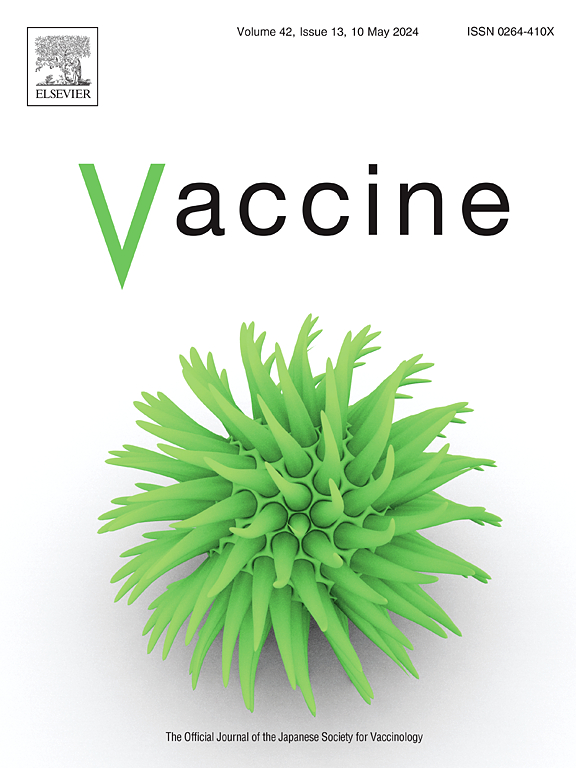表达COBRA血凝素的自我扩增mRNA诱导出持久的、广泛反应性的针对季节性甲型流感病毒的抗体
IF 4.5
3区 医学
Q2 IMMUNOLOGY
引用次数: 0
摘要
开发通用或广泛反应性流感病毒疫苗对于应对新出现的大流行毒株以及提高年度季节性流感病毒疫苗的有效性和使用寿命至关重要。下一代流感疫苗需要解决扩大疫苗诱导免疫反应的广度,以中和漂移变异,延长诱导免疫的寿命,并最好使用单针平台,以减少疫苗接种次数并扩大可用剂量。在本报告中,利用计算优化的广泛反应性抗原(COBRA)方法开发的流感血凝素序列,通过自我扩增的mRNA (samRNA)载体表达,在小鼠或雪貂单次接种后引发广泛反应性保护性免疫。代表H1 HA (Y2)或H3 HA (J4或NG2)的三种COBRA HA抗原从单个samRNA载体中表达,并单独或混合作为H1/H3 HA samRNA疫苗接种。此外,两种HA抗原在同一载体(Y2-J4或Y2-NG2)中作为双表达samRNA疫苗表达。接种这些samRNA疫苗的小鼠或雪貂具有持久的抗体,具有血凝抑制活性,可抵抗代表过去、现在和未来漂移的流感病毒变体的一组H1N1和H3N2流感毒株。此外,samRNA表达的COBRA HA抗原引起H1和H3特异性T细胞对HA头和干区域的反应。感染H1N1或H3N2流感病毒的动物几乎没有体重减轻或发病迹象,并且在感染后的肺部或鼻洗液中几乎没有检测到病毒。总体而言,表达COBRA HA抗原的samRNA载体在单次接种后可有效引发广泛反应性和保护性免疫反应。本文章由计算机程序翻译,如有差异,请以英文原文为准。
Self-amplifying mRNA expressing COBRA hemagglutinin elicits long-lasting, broadly reactive antibodies against seasonal influenza A viruses
Development of universal or broadly-reactive influenza virus vaccines is critical for addressing emerging pandemic strains, as well as improving the effectiveness and longevity of annual, seasonal influenza virus vaccines. The next generation of influenza vaccines need to address expanding the breadth of vaccine induced immune response to neutralize drifted variants, enhance the longevity of elicited immunity, and preferably use single-shot platforms that will reduce the number of vaccinations and expand the number of doses available. In this report, influenza hemagglutinin sequences, developed using computationally optimized broadly-reactive antigen (COBRA) methodology, were expressed from a self-amplifying mRNA (samRNA) vector to elicit broadly-reactive, protective immunity following a single vaccination of mice or ferrets. Three COBRA HA antigens representing an H1 HA (Y2) or two H3 HA (J4 or NG2) were expressed from individual samRNA vectors and administered individually or mixed as H1/H3 HA samRNA vaccines. In addition, two HA antigens were expressed from the same vector (Y2-J4 or Y2-NG2) as a dual expressing samRNA vaccine. Mice or ferrets vaccinated with these samRNA vaccines had long-lasting antibodies with hemagglutination-inhibition activity against a panel of H1N1 and H3N2 influenza strains representing past, current, and future drifted influenza virus variants. In addition, samRNA expressed COBRA HA antigens elicited H1 and H3 specific T cell resposnes against HA head and stem regions. Animals challenged with H1N1 or H3N2 influenza viruses had little weight loss or signs of morbidity and little to no virus detected in the lungs or nasal washes following challenge. Overall, samRNA vectors, expressing COBRA HA antigens, efficiency elicited broadly-reactive and protective immune responses following a single vaccination.
求助全文
通过发布文献求助,成功后即可免费获取论文全文。
去求助
来源期刊

Vaccine
医学-免疫学
CiteScore
8.70
自引率
5.50%
发文量
992
审稿时长
131 days
期刊介绍:
Vaccine is unique in publishing the highest quality science across all disciplines relevant to the field of vaccinology - all original article submissions across basic and clinical research, vaccine manufacturing, history, public policy, behavioral science and ethics, social sciences, safety, and many other related areas are welcomed. The submission categories as given in the Guide for Authors indicate where we receive the most papers. Papers outside these major areas are also welcome and authors are encouraged to contact us with specific questions.
 求助内容:
求助内容: 应助结果提醒方式:
应助结果提醒方式:


